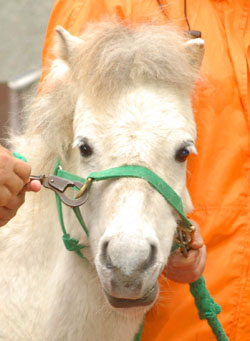|
Home Horse Breeds | First Posted: July 9, 2009 May 13, 2020 | |
Noma Pony
The Noma Pony, from the Noma region of Imabari in Ehime Prefecture, Japan, is the smallest of the local breeds. The Noma stands 10.1 hh. Lord Hisamatsu of Matsuyama Ham, in the 17th century, requested that the locals breed horses. These horses were the ancestors of the Noma breed and were derived from Mongolian stock. They were used for pack horses, riding and light draft on the remote islands. The terrain was mountainous. According to an article in the Japan Times "A Rare, Short Breed Returns,"by Edan Corkill, as of May 18, 2008 "the population now stands at 84 animals - a figure that you'd expect would have conservationists stomping their hooves in fear. But, when you consider it represents a 1,400 percent increase on the population of 30 years ago - which was six - you can understand why Ozawa and Co. are more likely to be rearing up in celebration. They are being preserved as part of the local cultural heritage." The article also stated: "...Nomas grew in popularity till about the middle of the 1800's, when Noma Uma Highland estimates there were about 300. Then, what was initially their defining characteristic — an unsuitability for warfare - came back to haunt them. During the Russo-Japanese War of 1904, the Japanese army was shocked to see how big the horses used by their adversaries were. Fearing what in Cold War parlance you might call a "horse gap," the Emperor ordered the breeding of large horses suitable for the trenches. The bureaucrats took to the task with perhaps a little too much vigor: The Baseikyoku (Agency of Equine Affairs) was established, thoroughbreds and other large breeds were imported from the West, a horse-racing industry was nurtured and, most surprisingly, the breeding of small horses was outlawed. As a result, Noma numbers nose dived, and the breed would have died out totally had it not been for some obstinate farmers hidden in the mountains of Ehime, who kept the horses for farm work...After the war, the introduction of trucks and tractors saw the Nomas all but disappear from the farm. By the 1970's, only six survived - a pair at the Dogo (now Tobe) Zoo in Ehime and one stallion and three mares in the collection of a private breeder, who was determined to keep them alive for their historical significance. In 1978, all six were brought together by Imabari City, which wasted no time in rebuilding the population. Erika and, indeed, all 83 of her kin, can be traced to those six horses. Then in 1989, Imabari centralized the breeding at Noma Uma Highland. 'The breed is now considered stable, and we are looking at ways to put them back into use,' explains Highland director Ozawa. He says the horse is particularly good for working with kids. They Noma Breed is considered rare. For More Information:
Oklahoma State University - Breeds of Livestock |